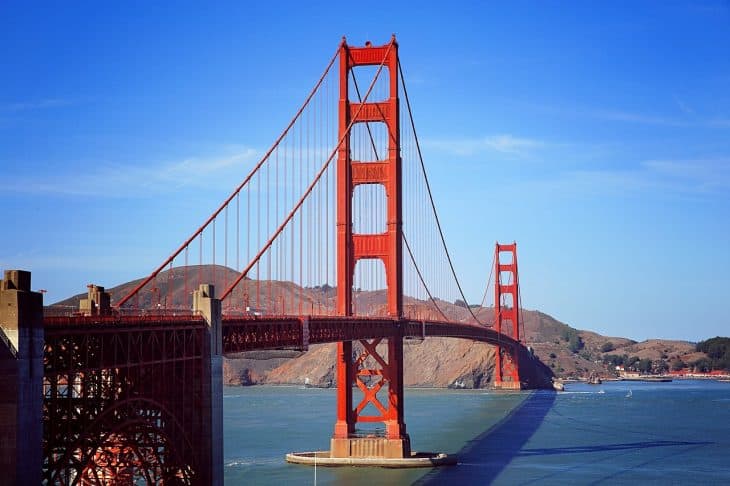
Aside from its foggy mornings, local seafood, and cool summers, the Golden Gate Bridge stands as one of San Francisco’s most iconic landmarks. Since its establishment in 1937, the Golden Gate Bridge has carried billions of people to their destinations. However, there’s still a lot of things to know about the history of this bridge. Take a closer look at the most photographed bridge in the world with these Golden Gate Bridge facts.
- It took over 4 years to build the Golden Gate Bridge from January 1933 until May 1937.
- A total of 11 men died throughout the construction.
- Around 19 other men were saved by an installed safety net.
- About 1.2 million steel rivets the bridge together.
- It cost approximately $35.5 million to build the Golden Gate Bridge.
- The bridge was under budget and ahead of schedule when it opened to vehicles on May 28, 1937.
- Before the existence of the bridge, the ferryboat served as the only way to go from San Francisco to Marin County.
- On average, the Golden Gate Bridge serves 112,000 vehicles, 10,000 pedestrians, and 6,000 bicycles daily.
- The Golden Gate Bridge can move up and down up to 5 meters (16 feet).
- The February 1976 Rolling Stone issue cover featured a photo of the bridge.
- It takes about 1 ½ to 2 hours walk across the Golden Gate Bridge.
- In August 2002, California’s Office of Homeland Security received an anon tip of terrorists plan to crash a plane into the bridge.
- The Civil War Era Fort Point National Historic Site lies at the south side base of the bridge.
- While fog covers the bridge for most of the day, it is usually foggier in the mornings and in the evenings.
- At the mid-span of the bridge are 3 foghorns that are 24.5 in long and 11 in diameter.
- The Golden Gate Bridge hails as the most photographed bridge in the world.
- High winds have closed the bridge 3 times: in 1951, 1982, and in 1983.
- Three babies have been reported to be born on the bridge, and all of them were boys.
- Today, the Golden Gate Bridge is only the 17th longest suspension bridge in the world.
- The Golden Gate Bridge counts among the seven wonders of the modern world.
Golden Gate Bridge Facts Infographics
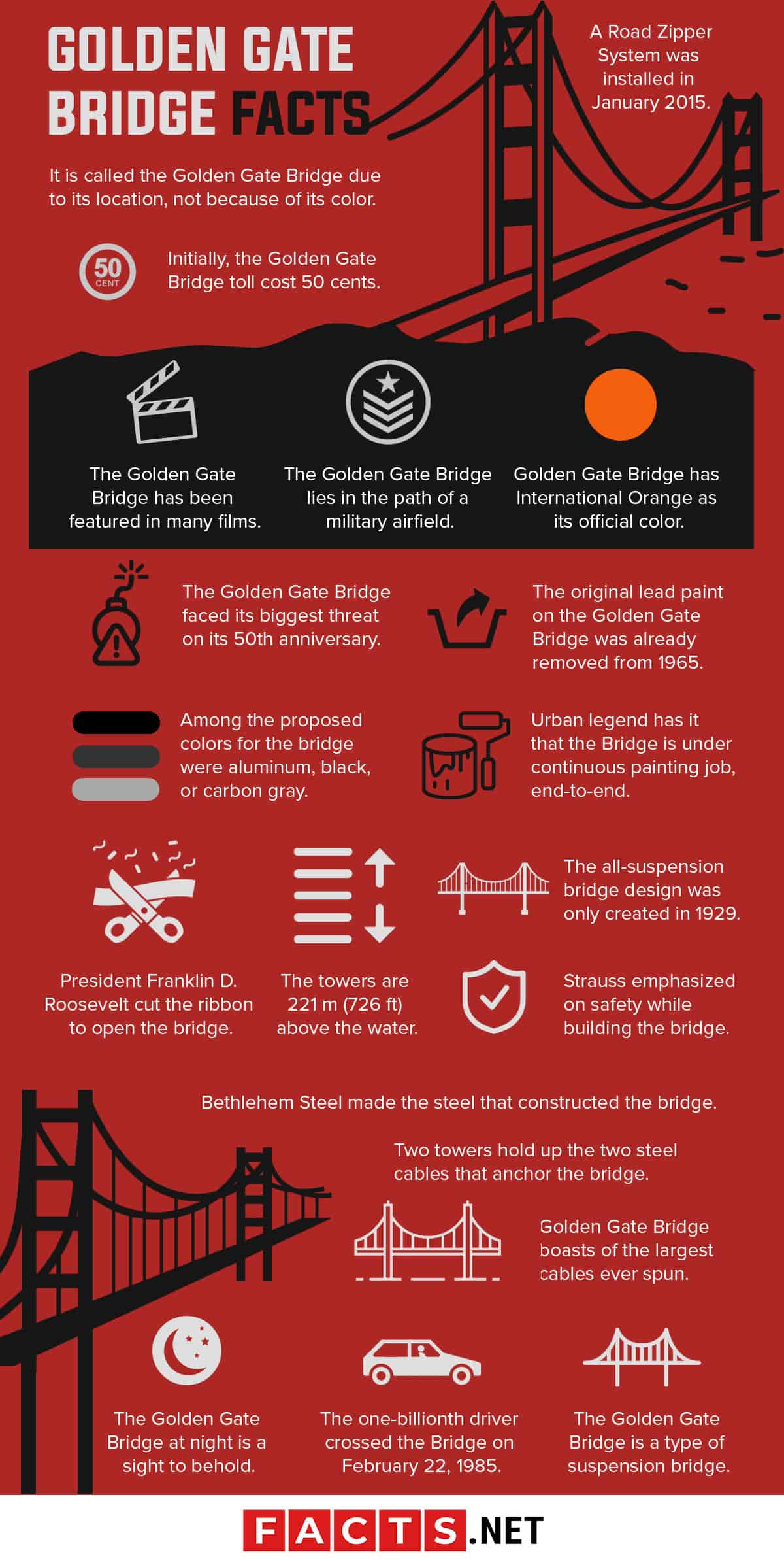
It is called the Golden Gate Bridge due to its location, not because of its color.
The internationally iconic bridge crosses the Golden Gate Strait. This water area flows between the San Francisco Peninsula and the Marin County Peninsula. Despite what its name might imply, the Golden Gate Bridge does not have a “golden” color.
Capt. John C. Fremont named the Coastal Mountain Range opening onto the San Francisco Bay the “Golden Gate.”
The Golden Gate Strait serves as the entrance to the San Francisco Bay from the Pacific Ocean. It stretches approximately 4.8 km (3 mi) long by 1.6 km (1 mi) wide. Currents of the strait flow at strengths of 4.5-7.4 knots.
The location of the Golden Gate Bridge is the link between San Francisco and Marin County.
This Pacific Coast Highway carries both U.S. Route 101 and California State Route 1 across the strait. The bridge also features a pedestrian walkway.
The Golden Gate Bridge lies in the path of a military airfield.
Known as the Chrissy Field, this airfield is located on the north end of San Francisco. However, the construction of the bridge along with the foggy weather in the Golden Gate caused the airfield to close in 1937.
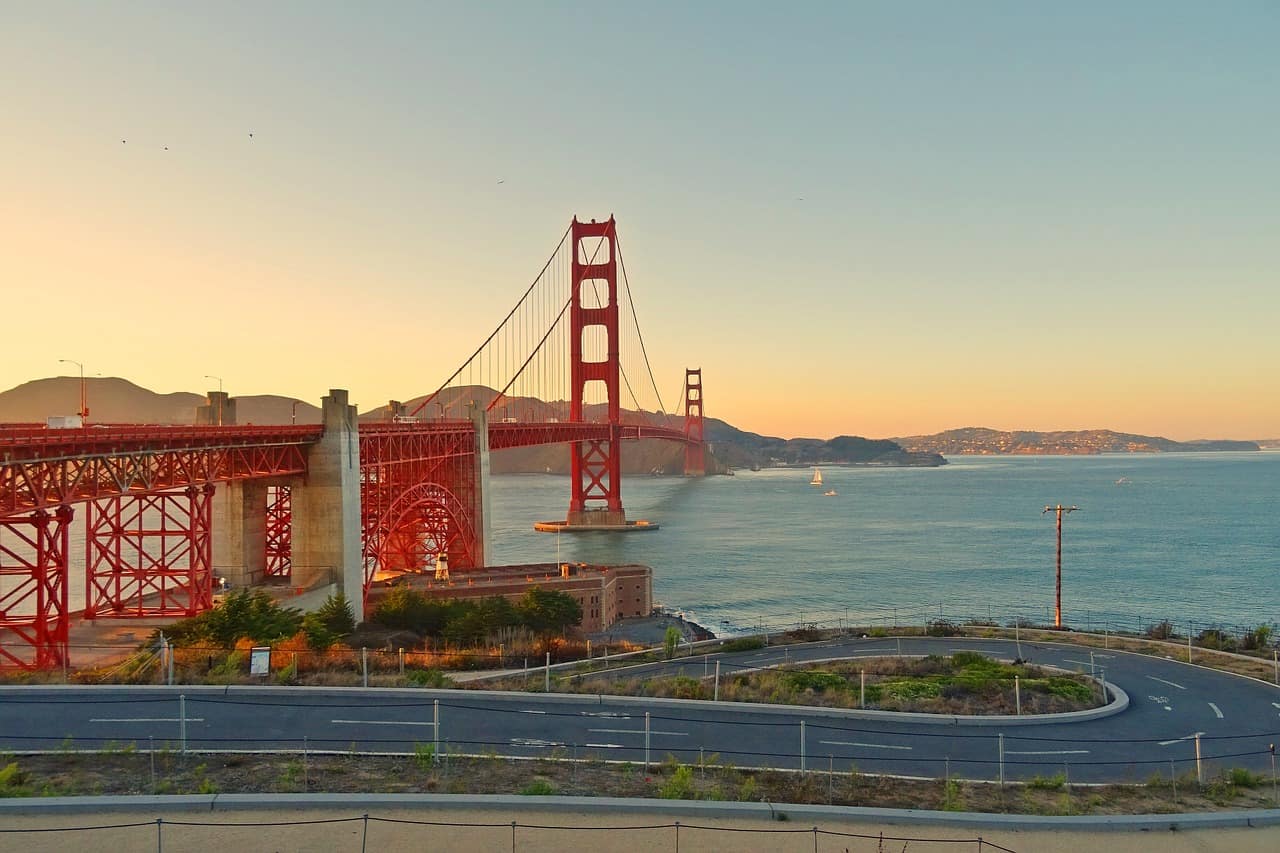
Golden Gate Bridge has International Orange as its official color.
This reddish-orange sealant is the type of paint that can protect the bridge from water and humidity. Aside from its harmonious blending with the bridge’s surroundings, the color is also easy to see in the fog.
American Fortune 500 company Sherwin-Williams supplies the paint for the bridge.
The CMYK formula for the iconic color is Cyan: 0%, Magenta: 69%, Yellow 100%, and Black: 6%.
The original lead paint on the Golden Gate Bridge was already removed from 1965.
Currently, the paint on the bridge combines a water-borne inorganic zinc primer and an acrylic topcoat.
Among the proposed colors for the bridge were aluminum, black, or carbon gray.
The U.S. Navy wanted it to be black with yellow stripes for greater visibility. However, consulting architect Irving Morrow did not favor of any of the said colors. First, the black was deemed unattractive and would reduce the scale of the bridge. Aluminum, on the other hand, would make the towers look tiny.
A Road Zipper System was installed in January 2015.
This movable median barrier system has a special design for traffic management and rider protection from cross-over accidents.
Urban legend has it that the Bridge is under continuous painting job, end-to-end.
However, this is only one of the commonly misquoted Golden Gate Bridge facts. In reality, the bridge only gets new paint and touch-ups whenever needed.
The Golden Gate Bridge stretches 1,280 m (4,200 ft)) long.
Its entire length suspends from two cables hung from towers. Meanwhile, the roadway midpoint is at 81 m (265 ft) above mean high water.
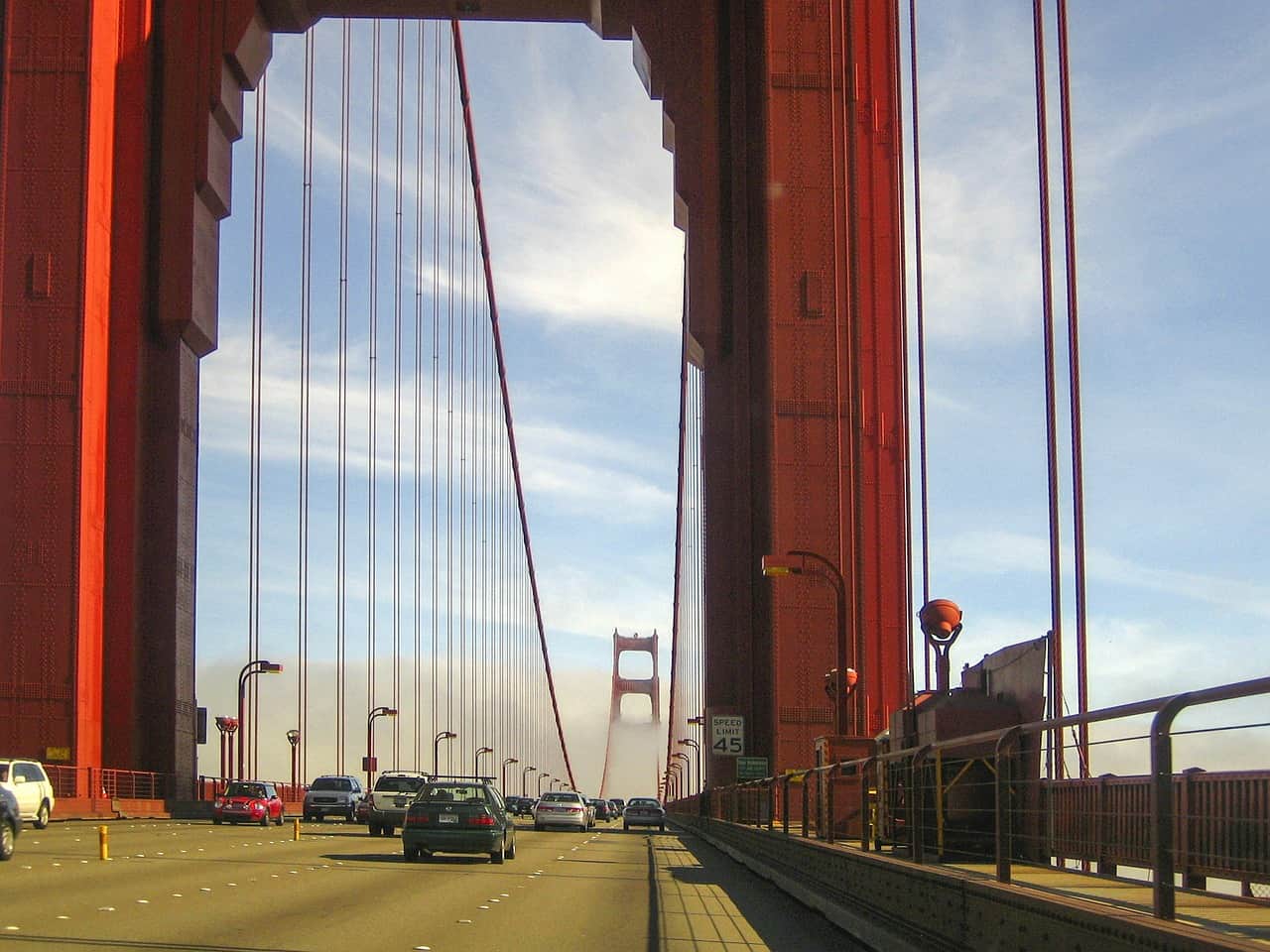
The Golden Gate Bridge measures 27 m (90 ft) wide.
Within its width are 6 driving lanes and 2 sidewalks. While the driving lanes measures 19 m (62 ft) between curbs, the sidewalks are 3 m (10 ft) each. Moreover, the street level is about 67 m (220 ft) above water.
The Golden Gate Bridge is made of about 80,000 tonnes (88,000 US tons) of steel.
Originally, the total weight of the bridge is 804,672 tonnes (887,000 US tons). However, it lost about 6,803 tonnes (7,500 US tons) in the 1980s due to the replacement of the roadway deck.
Bethlehem Steel made the steel that constructed the bridge.
They have plants in Pottstown, Maryland, Pennsylvania, and in Trenton, New Jersey. From the plants, they transport the steel to San Francisco via the Panama canal.
Two towers hold up the two steel cables that anchor the bridge.
Inside each of the cables are approximately 129,000 km (80,000 mi) of wire. There are around 600,000 rivets in each of the two towers.
The towers are 221 m (726 ft) above the water.
Above street level, the Golden Gate towers stand at 152 m (500 ft). They weigh 40,000 tonnes (44,000 US tons) and sit 1280 m (4,200 ft) from each other.
Golden Gate Bridge boasts of the largest cables ever spun.
Each of the two main cables measure 7,659 long. At over 3 ft in diameter, they contain at least 27,570 parallel wires. This length is enough to circle the world at the equator more than three times. How’s that for neat Golden Gate Bridge facts?
The Golden Gate Bridge at night is a sight to behold.
The Bridge’s lighting at this time of the day makes it seem like the tower spires dissolve in the darkness. On the other hand, the morning sight of the Bridge is the most enchanting as it is often shrouded in mist.
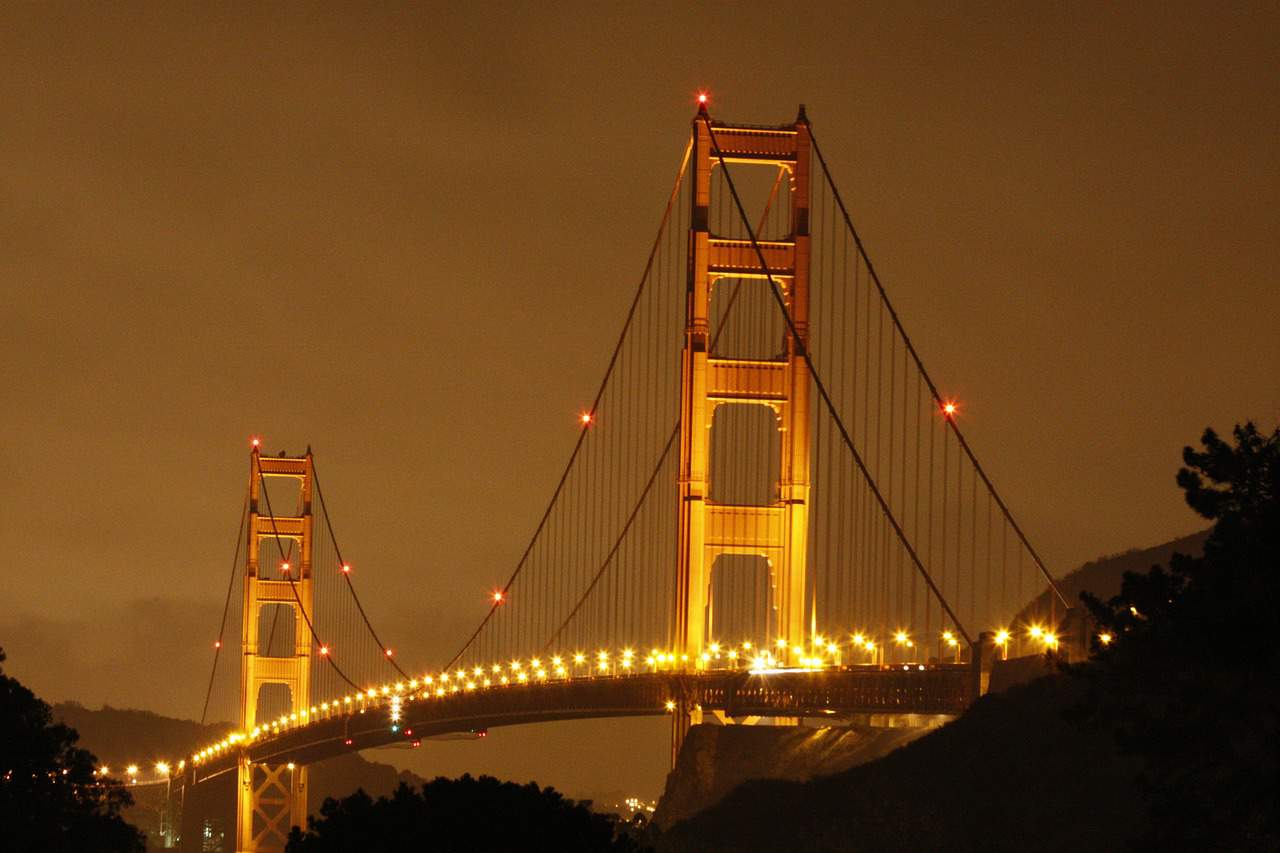
The one-billionth driver crossed the Bridge on February 22, 1985.
The billionth person to cross the Golden Gate Bridge was dentist named Arthur Molinari. Due to this historical milestone, Molinari received a bridge-construction hard hat and a case of Champagne.
The Golden Gate Bridge is a type of suspension bridge.
From the time it was built in 1937, it stood as the longest suspension bridge in the world. However, the completion of the Verrazano-Narrows Bridge in 1964 broke this record. This other bridge connected the New York City boroughs of Staten Island and Brooklyn.
The song entitled “California Here I Come” seemed to mention the Golden Gate Bridge.
Its famous lines open with “Golden Gate California, Here I Come.” However, the fact that Al Holson wrote it in 1921 only proves that this was not the case.
The Golden Gate Bridge was built according to Charles Crocker’s call for a bridge to span the Strait.
However, the railroad entrepreneur’s vision did not gain traction until the early 20th century. By this point, the area’s population had been growing rapidly. The area also faced increasing traffic congestion at the ferry docks.
The Golden Gate Bridge had to earn the approval of the War Department.
The US War Department owns the land on both sides of the Golden Gate strait. Hence, the need for their authorization over the construction of the bridge. The Department granted a temporary construction permit in December 1924 and issued a final permit in August 1930.
Some experts doubted the possibility of the Golden Gate Bridge.
Scientists and experts considered how incredibly strong the water currents between Marin and San Francisco tended to be. Aside from that, the water in the middle of the strait reaches depths of 102 meters. The regular amount of wind and fog in the area also factored in the delicate conditions of building the Golden Grate Bridge.
In 1916, the San Francisco city engineer opened the floor for other engineers’ ideas for a bridge.
A man named Joseph Strauss designed a very affordable bridge for only $17 million. However, it was not that attractive in the eyes of many people. Hence, local authorities asked him to change the design and work with other experts.
The all-suspension bridge design was only created in 1929.
Consulting engineers Leon S. Moisseiff and O.H. Ammann had persuaded Strauss to accept the design of what is now known as the Golden Gate Bridge. From there, senior engineer Charles Alton Ellis collaborated remotely with Moisseiff as the principal engineer of the project.
Ellis and other experts like Irving Morrow redesigned the bridge.
As the residential architect, Morrow designed the overall shape of the bridge towers and the lighting scheme. He also takes credit for Art Deco elements like the tower decorations, streetlights, railing, and walkways.
Joseph Strauss made the bridge's original design and served as the project's chief engineer.
Strauss’ first rendition of the Golden Gate Bridge featured a clunky hybrid of a cantilever and suspension bridge. Critics claimed that it looked like an “upside-down rat trap.” While it was functional, the design was far from elegant for something that would be a tourist attraction in the near future.
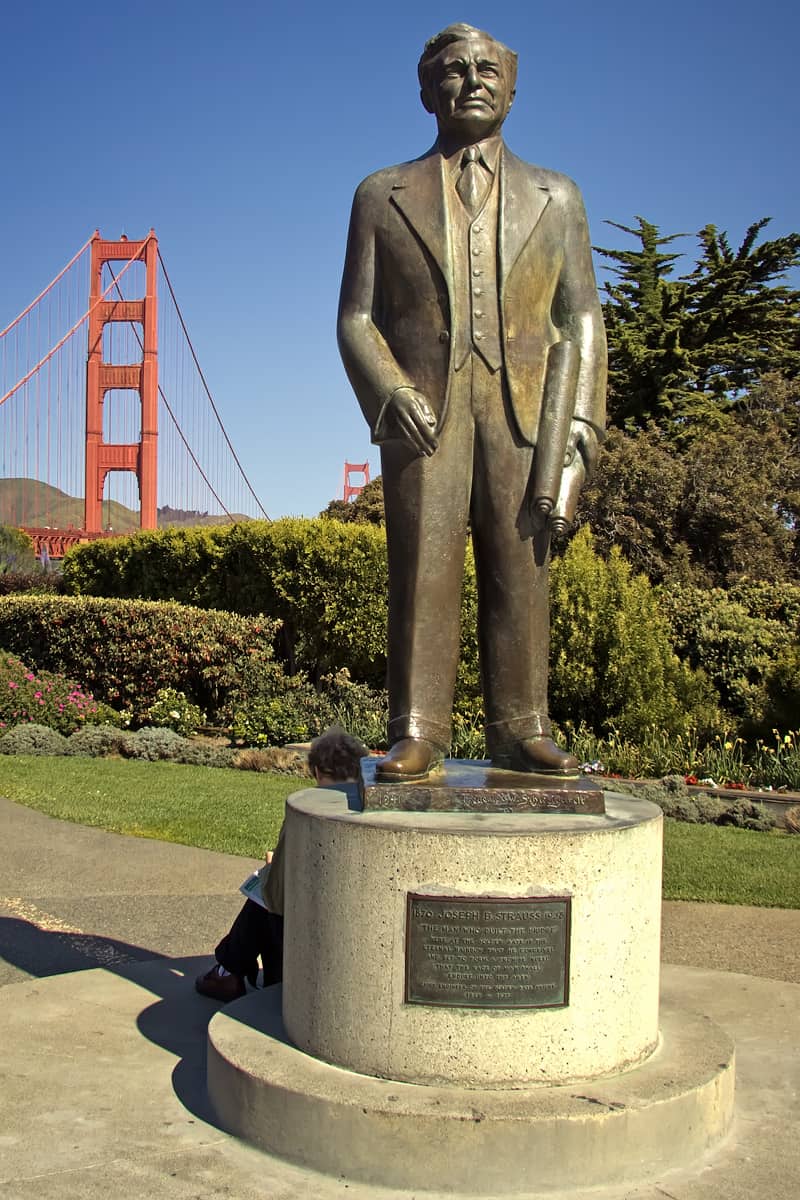
The groundbreaking of the Golden Gate Bridge was held on January 5, 1933.
The Golden Gate Bridge’s grand opening welcomed the big event with a parade to Chrissy Field. Opening remarks were followed by a message from President Herbert Hoover. Other parts of the ceremony included a 21-gun salute followed by a bridge drawn in skywriting.
President Franklin D. Roosevelt cut the ribbon to open the bridge.
Instead of attending the ribbon-cutting ceremonies personally, the 32nd president of the U.S. made the gesture remotely via the telegraph. Definitely one of the stranger Golden Gate Bridge facts.
FDR pressed the telegraph key in the White House at noon on May 28, 1938.
Through this gesture, Roosevelt signaled the bridge’s opening to the entire world. At 3 p.m. On the same day, a fleet of 42 Navy ships sailed under the bridge.
The same company that built the Brooklyn Bridge supplied the cables used in the Golden Gate Bridge.
Strauss needed cables strong enough to support the structure of the bridge and bend 27 ft laterally in the high winds. Moreover, they had to be made right on the construction site. With Roebling’s Sons Co. creating the cables for the Brooklyn Bridge 52 years earlier, this achievement made them perfect for the job at hand.
Later on, the company developed a method called parallel wire construction and began spinning in 1935.
Strauss emphasized on safety while building the bridge.
Throughout the bridge’s construction, Strauss prohibited any kind of goofing off. Even standing on one foot while working on the site can get a man fired. Other rules included having to wear glare-free goggles and using hand and face cream for high wind protection. Strauss had the workers follow special diets that could fend off dizziness.
Strauss had a $130,000-net installed under the bridge for safety.
This device manufactured by the J.L. Stuart Company is similar to those strung below a circus trapeze. Moreover, Strauss had the E.D. Bullard Company create special hard hats for the bridge workers and required for them to wear it at all times.
The Golden Gate Bridge net is a movable safety net that Strauss innovated himself.
Unfortunately, the bridge failed one time in February 1937 after giving under the weight of a collapsed scaffolding. Thirteen men were on the scaffolding. Of these men, 1 of them jumped clear, 2 survived the fall, but the rest were killed.
Apart from that incident, the Golden Gate Bridge net successfully saved 19 other men who were then dubbed the Halfway to Hell Club.
The type of fog on the Golden Gate Bridge weather is known as the advection fog.
This occurs upon the passing of moist air over a cool surface and moves horizontally. Usually, it appears in the late afternoon as the bridge succumbs to the bank of fog rolling in from the ocean. What makes such Golden Gate Bridge facts more interesting is how the shape of the Bridge affects the direction of the fog.
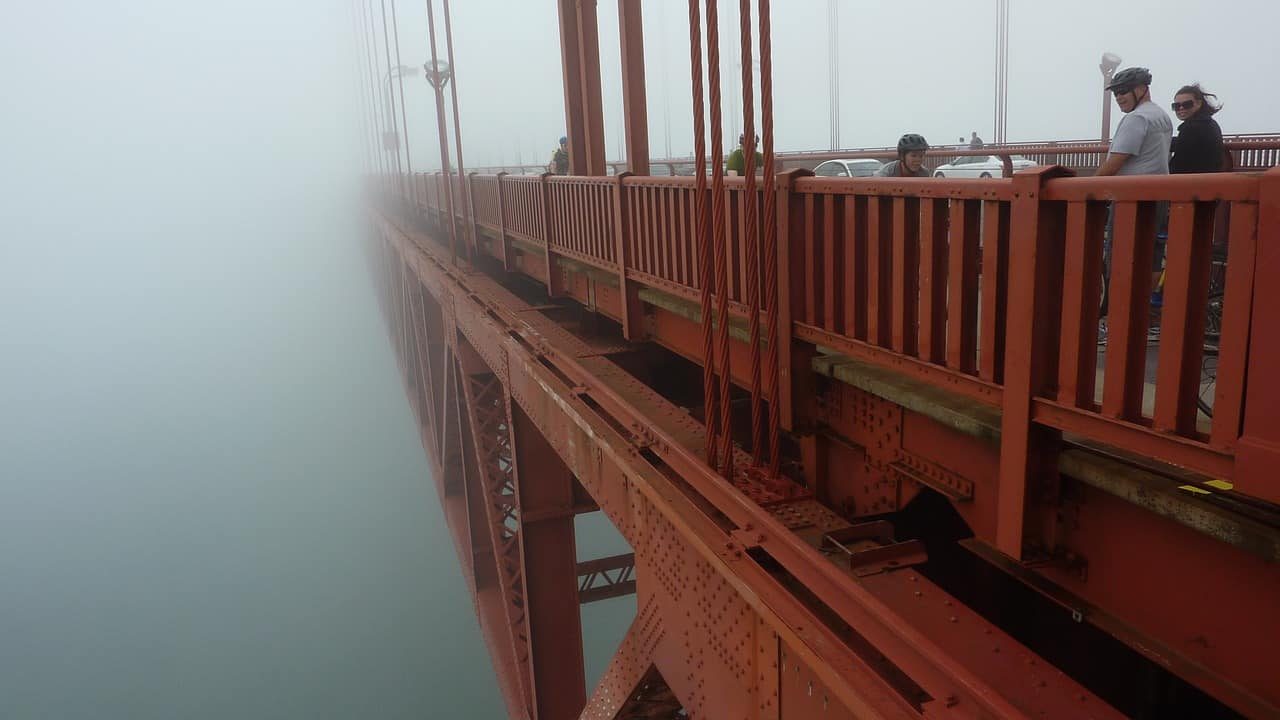
The Golden Gate Bridge usually gets 105 foggy days per year.
Still, this number does not make it the foggiest place on land in the world. Point Reyes National Seashore and Argentia, Newfoundland holds this title as they experience 200 foggy days a year.
When a quake hit the bridge in June 1935, there were construction workers on top of the south tower.
They claimed the limberness of the tower as it swayed 16 feet each way. About 12 guys were atop the tower with no way to get down. As the tower swayed back and forth, guys were laying and throwing up on the deck.
In 1930, local government and residents agreed to sell bonds to the public to raise money for the bridge.
As the new design was bound to cost about $30.1 million, a great need for financing arose. Unfortunately, the Wall Street Crash of 1929 made it difficult for the governments to sell bonds at the time. Eventually, the Bank of America based in San Francisco agreed to buy all the bonds as help to the local economy.
There were a few times when the Bridge was closed for special occasions.
The 50th and 75th anniversaries of the Golden Gate Bridge were among the most memorable ones. These occasions featured visits from dignitaries such as President Franklin D. Roosevelt and President Charles de Gaulle of France special cases of closing the Bridge.
The Golden Gate Bridge faced its biggest threat on its 50th anniversary.
On that day, 300,000 pedestrians crossed the bridge, which was way more than the expected capacity. While the bridge flattened, it did not give due to the reinforcement done the previous year.
The Golden Gate helped relieve transit stress on the San Francisco Embarcadero.
Before the completion of the Golden Gate and Bay Bridge, the Embarcadero stood as the second busiest transit terminal in the world. It came only second to the Charing Cross Station in London.
On October 27, 1989, the Golden Gate Bridge held a record of 162,414 vehicles in .
This number was due to the closing of the Oakland Bay Bridge. Its unfortunate sister bridge had a collapsed upper deck during the 7.1 Loma Prieta Earthquake. While it hit San Francisco and the Bay Area, the Golden Gate Bridge miraculously came out unscathed.
The Golden Gate Bridge has been featured in many films.
Aside from the San Francisco skyline, the Golden Gate Bridge has stolen the scene in dozens of films. Among these films are Marvel‘s Ant-Man, Hulk, Rise of the Planet of the Apes, Star Trek, Superman, The Love Bug, and Vertigo. How’s that for cool Golden Gate Bridge facts?
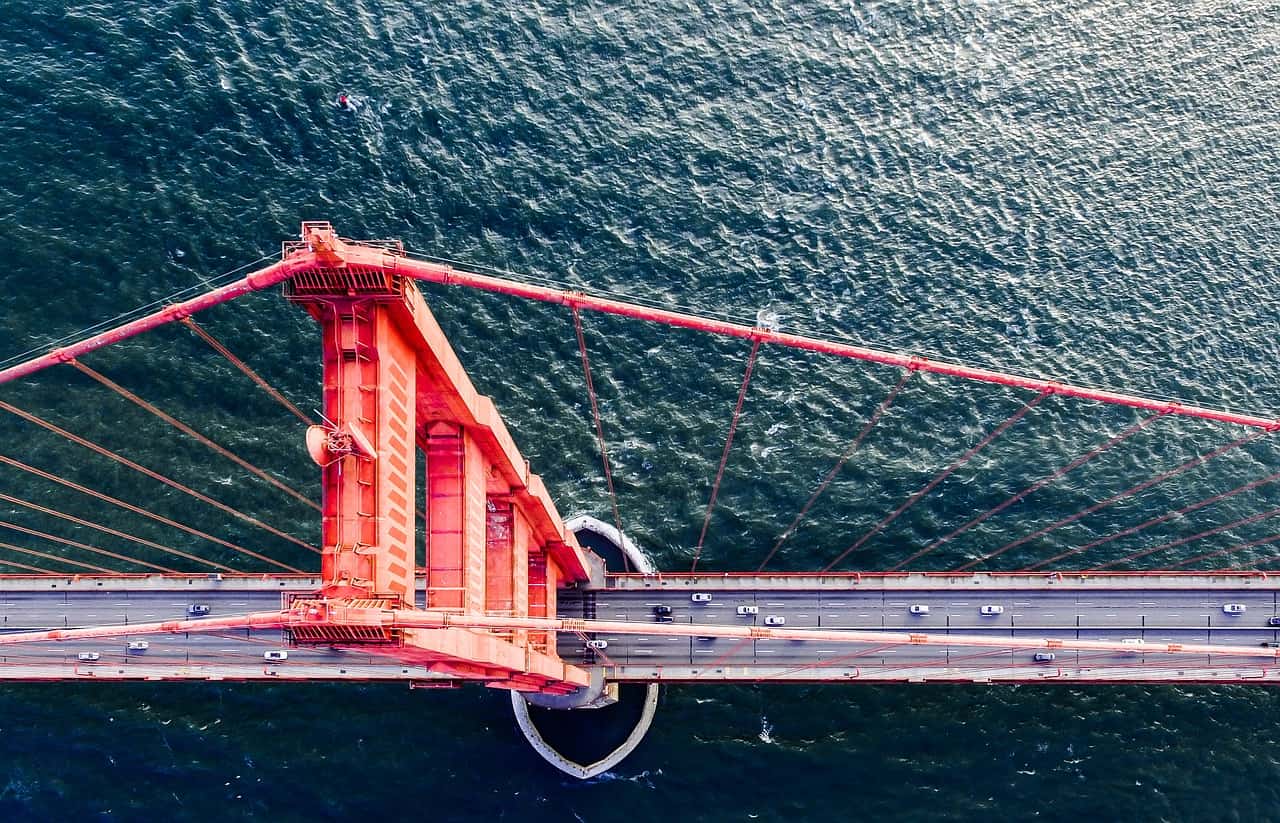
The first-ever Golden Gate Bridge suicide was a World War I veteran.
Harold Wobber decided his fate on August 7, 1937. Reports claim that his last words before jumping were “This is where I get off.” Definitely one of the more unfortunate Golden Gate Bridge facts.
Suicide prevention hotline phones hang along the path on the bridge.
These installations provide troubled people with access to professional help. Of all the people who have committed suicide from the bridge, only 33% were residents of San Francisco.
Over 1,600 people have jumped off the bridge since its completion in 1937.
The fatal jump takes 4 seconds for a person to drop the 260 feet down to the water below. Due to impacts of up to 75 mph, very few jumpers survive the initial fall into the water.
July 2013 saw a 24-hour period where 4 people succeeded in their suicide attempts.
Of all the jumpers of the Golden Gate Bridge, only 26 people were known to have survived the initial impact. However, there was one woman who jumped off the bridge twice to complete a prior unsuccessful suicide attempt.
Authorities eliminated pedestrian access to the Bridge at nightfall.
Alongside the suicide prevention hotline phones hung along the paths, this curfew was just one of the many efforts to diminish the suicide attempts on the site.
Aside from the entry points, the whole length of the Bridge also has enforced security.
Further assistance for potential jumpers does not end there. Aside from the increased amount of patrols, specific training and awareness were enforced on other bridge staff, including painters. Hence, every single one of the bridge’s staff can quickly respond to an incident.
A suicide deterrent net on the Golden Gate Bridge is currently in the works.
In June 2014, San Francisco’s Golden Gate Bridge Board of Directors passed a unanimous approval of a $76 million fund. This allocated funds for the erection and funding of a suicide deterrent net on the Bridge. Construction began in August 2018 and is expected to complete in 2021.
In 1930, the construction of the Golden Gate Bridge faced 2,300 lawsuits.
One of these lawsuits came from the Southern Pacific Railroad who owned 51% of the ferry company that transported commuters and cars between San Francisco and Marin County. Aside from them, Ansel Adams and the Sierra Club opposed the Bridge’s construction as well, on the grounds that the Bridge would mar the beauty of the strait.
Golden Gate Bridge needed several approvals before construction began.
This lengthy process included several favorable court rulings, an enabling act from the State legislature, and two hearings prior to the approval of the U.S. Department of War.
The Department of War feared that any bridge across the Bay would hinder navigation. Moreover, the ferry service operated by the Southern Pacific Railroad held a mass boycott against the bridge.
Initially, the Golden Gate Bridge toll cost 50 cents.
When it first opened, drivers had to pay this amount to cross the Bridge in either direction. Today, northbound drivers (leaving San Francisco) pay no fees. Meanwhile, southbound drivers (entering San Francisco) have to pay $6 in cash or $5 in Fastrak pass. This regulation has been effective since September 2, 2008.
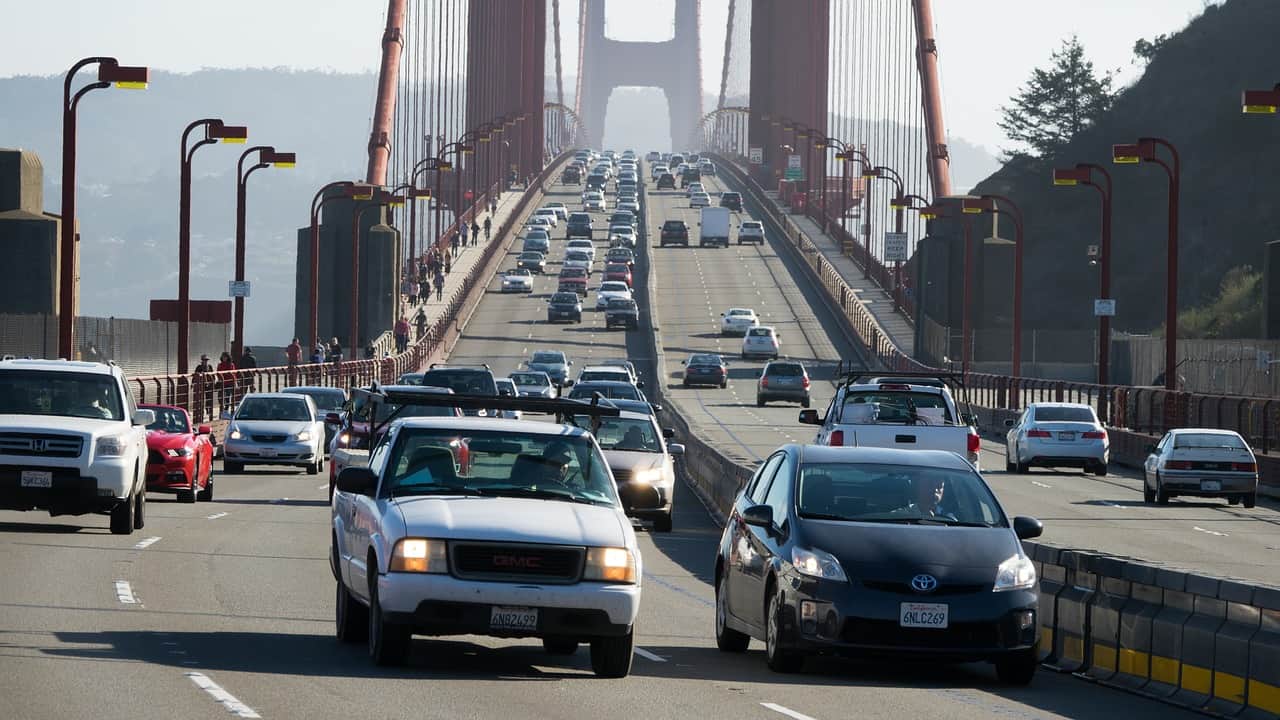
The Golden Gate Bridge was the first bridge to collect toll only in one direction.
This unusual way of improving profitability has been mandated since October 19th, 1968.
Cars with 3 or more people are exempt from the Golden Gate Bridge toll fee during rush hour.
This period covers 5:00-9:00 a.m on weekdays, and 4:00-6:00 p.m on weekends. Definitely one of the more useful Golden Gate Bridge facts.
On average, the Golden Gate Bridge has 40 million crossings per year.
As of April 2013, 2 billion vehicles had crossed the infamous bridge already. This estimate comes from the data of the southbound traffic (with the toll) as it has a more accurate measure than northbound traffic.
The right side of the north lane acts as a vista point for Golden Gate Bridge photographs.
This well-photographed station has another version towards the left. When heading the North after crossing the Bridge, drivers will see the Marin Headlands. This is part of the expansive Golden Gate National Recreation Area and offers great views of the Bridge.
Golden Gate Bridge parking lots line the southeast and northeast side of the Bridge.
With these options, people can park and take leisurely walks across the Bridge. In total, he Southeast Visitor Parking Lot has 37 parking spaces. This includes 26 general spaces, 6 bus stalls, and 3 spaces for visitors with disabilities.
Metered parking costs $0.25 per 15 minutes. Moreover, a nearby satellite lot parking charges $5 per day on weekends and holidays. On the other hand, the Northeast Visitor Parking Lot offers free parking within a 4-hour limit
Most San Francisco bus tour companies offer drop-off and pick-up services for the bridge.
Visitors may also cross Bridge by bike as there are also bicycle rental options in the nearby Marina District. Fisherman’s Wharf neighborhoods are also a great choice to avoid potentially full parking lots.
Was this page helpful?
Our commitment to delivering trustworthy and engaging content is at the heart of what we do. Each fact on our site is contributed by real users like you, bringing a wealth of diverse insights and information. To ensure the highest standards of accuracy and reliability, our dedicated editors meticulously review each submission. This process guarantees that the facts we share are not only fascinating but also credible. Trust in our commitment to quality and authenticity as you explore and learn with us.
